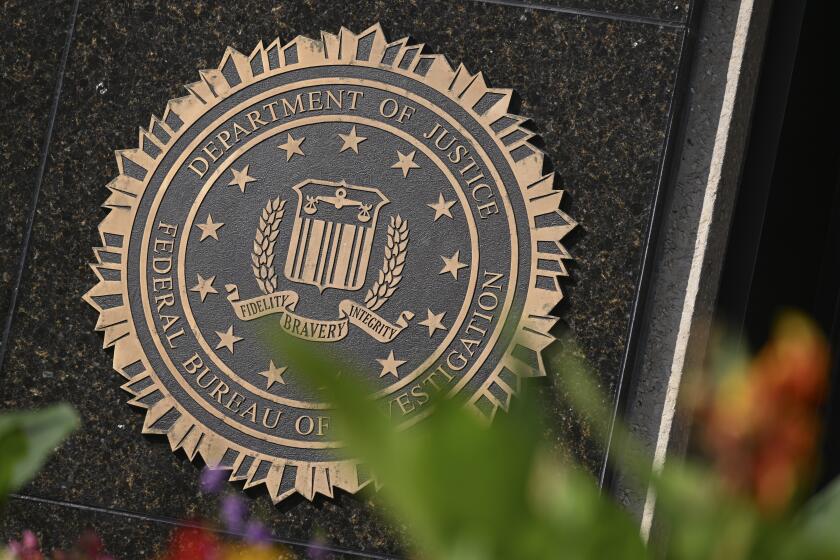Nearly 24,000 Foreign Men Register in U.S.
The federal government’s controversial new requirement that foreign men from many, mostly Muslim, nations register with U.S. authorities has thus far drawn almost 24,000 men nationwide -- more than one in 10 of whom face possible deportation, according to Justice Department officials.
The program also has led to the detention of 1,169 foreign nationals.
The figures for detentions and deportations are considerably higher than those offered previously by government officials.
With two more rounds of registration scheduled through the next two months, the numbers of people arrested or facing deportation already greatly exceed the 765 foreigners -- also mostly Middle Easterners and South Asians -- detained by the Immigration and Naturalization Service as part of the post-Sept. 11 investigation.
The registration program, which includes a companion effort at U.S. airports, land borders and other points of entry, has resulted in the arrests of three suspected terrorists, said Kris Kobach, counsel to Atty. Gen. John Ashcroft.
Authorities declined to provide details, but it is known that the fingerprints and identities of all registrants are checked against databases and lists of suspected and known terrorists and other criminals.
Another person detained through registration and now targeted for deportation, Kobach said, is a Saudi national who came to Florida for flying lessons -- a path also followed by three of the Sept. 11 suicide hijackers.
“It’s gone very well,” Kobach said of the program in a telephone interview. “We think it’s been a worthwhile investment of our resources.”
But, as with the post-Sept. 11 arrests, the registration program has evoked fierce criticism from civil libertarians and representatives of the Middle Eastern community.
Critics say the program unfairly targets otherwise law-abiding men by requiring them to register at INS offices and then ordering them deported for even minor visa irregularities.
“It’s almost a setup for deportation,” said Ibrahim Hooper, spokesman for the Council on American-Islamic Relations.
The registration program has two parts, both focusing on foreigners who arrived on temporary visas. Among those exempt are naturalized U.S. citizens and legal permanent residents, or green-card holders.
Men 16 and older from 25 nations who had arrived in the United States by last September are required to register at INS offices. Except for North Korea, all of the nations covered by the program are heavily Muslim in population. Ashcroft last week added five nations -- Bangladesh, Egypt, Indonesia, Jordan and Kuwait -- to the list of countries whose men must report if they are living in the United States.
Men and women arriving since September on temporary visas have been required to register at airports and other ports of entry. Under that part of the program, officers had registered 30,828 foreign nationals from more than 100 nations as of last Tuesday, authorities said. They had turned back or arrested 330 people for criminal or other violations, the officials said.
Federal officers at ports consider such matters as suspicious travel patterns, place of birth and intelligence information when considering whether to register new arrivals, authorities said.
For many men -- those whose visas have expired but who are awaiting legal residence because they have relatives in the United States or are being sponsored by employers -- the domestic program offers a difficult choice.
If they fail to register, they risk deportation and even criminal prosecution. If they show up, they also may face deportation, although they can try to throw themselves on the mercy of the INS or an immigration judge. Thousands have chosen to come forward.
As of Jan. 14, a total of 2,477 men who showed up at INS offices nationwide had been issued notices to appear, the initial step in the deportation process, said Jorge Martinez, a Justice Department spokesman. Such cases are typically referred to immigration court for “removal,” or deportation.
Of the almost 1,200 initially detained, 164 remained in custody as of last Tuesday, when the most recent statistics were compiled, officials said.
Most of those detained had immigration violations, but 15 of them were considered serious felons, officials said. Among the more than 500 taken into custody and put into deportation proceedings in the Los Angeles area last month were three Iranians with convictions for child molestation, assault and theft, authorities said.
Despite the large number of arrests and possible deportations, Justice officials say the program is foremost a national security effort. They deny that it was crafted to snare people in violation of their visas -- though that is one practical effect.
Just last week, the Justice Department granted a 12-day grace period for people from Iran and 19 other countries who missed their first deadlines for registering.
Activists who favor reduction of immigration applaud the effort. They call it an overdue step to begin apprehending some of the estimated 4 million immigrants who entered the country legally and then broke the law by overstaying or otherwise violating their visas. Visa violators represent about 40% of an overall illegal population estimated at 8.5 million.
“As Confucius says: When you enforce immigration law, you inconvenience illegal aliens,” said Dan Stein, executive director of the Federation for American Immigration Reform, which favors a crackdown.
Those being registered are photographed, their fingerprints are taken and they are asked a series of biographical questions, including their places of birth, their parents’ names, their jobs or schools, their current addresses and other details. The information is placed in federal databases.
The system -- known formally as the National Security Entry-Exit Registration System -- is modeled on the longtime practice in European nations and elsewhere that requires foreigners to check in periodically with authorities.
“It’s a common-sense approach to keep track of visitors and ensure that they do what they said they were going to do,” Kobach said. “This will allow us to scrutinize what they’re doing here, and to locate them if it turns out we get some information that this person is a suspect in terrorism or something similar.”
The goal is to be able to tell almost instantly when visitors are out of status or otherwise in violation -- and where they live, and whether they pose a threat. That information hardly exists now in a system that depends largely on self-reporting and filling out paper forms.
The effort grew directly out of the experiences of Sept. 11. All 19 hijackers were Arab men who entered the United States on legal visas. Three had violated the terms of their visas by the time they boarded their respective aircraft Sept. 11 -- but the INS had no way of knowing. An eleventh-hour hunt that could have disrupted the plot was unsuccessful just weeks before Sept. 11 when the FBI could not find one of the hijackers, even though he had entered the country legally the previous month.
After Sept. 11, Congress renewed a mandate that some tracking of all foreign visitors be in effect by 2005.
It is a massive undertaking that has previously died amid political opposition and implementation difficulties.
That mandate requires that a scaled-down version of registration be applied within three years to all foreign nationals -- even the multitudes from Mexico, Canada and other nations. The congressional action envisions the creation of a computerized system to inspect millions of foreign travelers as they enter and leave the United States.
Implementing the new requirement will be one of the greatest challenges facing the Department of Homeland Security, which is about to swallow up the INS. In the most recent year, authorities recorded more than 300 million entries by foreign nationals.
More to Read
Sign up for Essential California
The most important California stories and recommendations in your inbox every morning.
You may occasionally receive promotional content from the Los Angeles Times.










